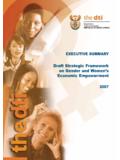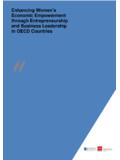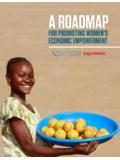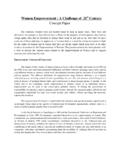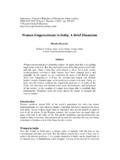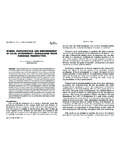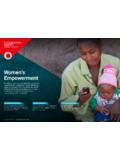Transcription of Tracking the money for women’s economic empowerment: …
1 1 Tracking the money for women s economic empowerment : still a drop in the oceanOECD DAC NETWORK ON GENDER EQUALITY (GENDERNET) JUNE 2016T his brief, produced by the OECD-DAC Network on Gender Equality (GENDERNET) and the DAC Working Party on Development Finance Statistics ( WP-STAT ), provides an overview of official development assistance (ODA) going to women s economic empowerment . It identifies key trends, financing gaps and priority areas for improving donor support in this s ability to enjoy their rights, make strategic choices, and exercise agency in key areas of their lives is closely linked to being able to generate regular, adequate and independent women s economic independence can increase their autonomy, enhance their economic and social status, and shift power relations between women and men, including within the household.
2 New opportunities associated with employment can also be empowering, such as the freedom to engage in activities outside the home, develop skills and confidence, build social networks, and raise women s economic empowerment defined as women s capacity to contribute to and benefit from economic activities on terms which recognise the value of their contribution, respect their dignity and make it possible for them to negotiate a fairer distribution of returns4 is a prerequisite for achieving gender equality and building inclusive and prosperous societies. 1. Statistics contained in this brief are based on reporting by OECD Development Assistance Committee (DAC) members using the DAC gender equality policy marker. They exclude non-sector allocable aid since several members do not apply the gender equality marker on these forms of aid.
3 The brief is based on the latest available data (2013-14). Aid to women s economic empowerment is calculated as aid to the economic and productive sectors that targets gender equality as a principal or significant objective. 2. Pathways of women s empowerment Research Programme Consortium (2011), empowerment : A journey not a destination, final synthesis report, Brighton: Pathways of women s empowerment Eyben, R. (2011), Supporting Pathways of women s empowerment : A Brief Guide for International Development Organisations, Pathways Policy Paper, October 2011, Brighton: Pathways of women s empowerment RPC. KEY FINDINGS Aid committed by DAC members to women s economic empowerment reached USD billion on average per year in 2013-14 a rise from USD billion in 2007-08.
4 This is the first upward trend in aid to gender equality in the economic and productive sectors since 2007. However, less than a quarter (24%) of DAC members aid to the economic and productive sectors targeted gender equality as either a primary or secondary objective in 2013-14. This is much lower than the average of 35% across all sectors. Aid targeting women s economic empowerment as the principal objective remains especially low, at USD 861 million in 2013-14. This is just 2% of the aid going to the economic and productive sectors a mere drop in the ocean. While gender equality is fairly well integrated into donor support to agriculture, and employment, the proportion of aid to other economic and productive sectors remains very small.
5 The gender focus is weakest in the infrastructure sectors such as energy and transport. This is despite strong evidence that women s access to quality infrastructure is essential for expanding their economic opportunities, reducing unpaid work burdens, and advancing gender equality. European Union/ECHO2 OECD DAC NETWORK ON GENDER EQUALITY (GENDERNET) Tracking THE money FOR women S economic empowerment : still A DROP IN THE OCEAND espite this, persistent underinvestment in women s economic empowerment means that improvements in girls education have not translated into reduced gender gaps in the labour market or equal access to and control over economic resources. While legal reforms have expanded women s economic rights and opportunities, women still face gender-based job restrictions in 100 economies around the world, and in 18 economies husbands can legally prevent their wives from women s labour force participation globally has stagnated over the past 30 women remain concentrated in gender segregated occupations at the lower end of the employment hierarchy,7 leading to gender pay gaps which persist both in developing and OECD Globally, women earn on average 24% less than women continue to make up the largest share of workers in informal forms of employment that are typically precarious, poorly paid and which lack basic social protections, such as unpaid family workers.
6 Subsistence farmers, homeworkers, and domestic This makes women disproportionately vulnerable to poverty and can render their economic contributions invisible. The 2030 Agenda for Sustainable Development provides an ambitious roadmap to eradicate poverty and achieve sustainable development for all. women s economic empowerment cuts across the Sustainable Development Goals (SDGs), with targets on recognising and valuing unpaid care and domestic work, women s equal rights to economic resources, full and productive employment and decent work, and equal pay for work of equal The Addis Ababa Action Agenda of the Third International Conference on Financing for Development further commits to ensure women s equal rights, access and opportunities for participation and leadership in the economy.
7 Recognising this as essential to achieve sustainable Other recent international commitments include the target adopted by G20 leaders in 2014 to reduce the gender gap in labour force participation in G20 countries by 25% by The OECD and ILO are working together to monitor progress in meeting this 25 by 25 These newer commitments build on longer-standing ones, such as those enshrined in the Beijing Platform for Action on women s roles in and contribution to the economy. Adequate financing from all sources will be required for the full and accelerated implementation of both new and long-established commitments to empower women economically and shape economies that work for women . MethodologyThe OECD-DAC gender equality policy markerThe OECD uses the DAC gender equality policy marker to track aid activities that target gender equality as a policy objective.
8 Aid activities can be classified as targeting gender equality as a principal or significant objective, or as not targeted . Principal means that gender equality is a primary objective of the activity and refers to stand-alone projects targeting gender equality. Significant means that gender equality is an important but secondary objective and refers to projects that mainstream gender equality. Not targeted means that the activity has been screened using the policy marker but was found not to be targeting gender equality. The marker contributes to strengthening transparency and accountability in donor financing for gender equality and women s rights. For more information about the gender equality policy marker, see: International Bank for Reconstruction and Development/The World Bank Group (2015), women , Business and the Law 2016: Getting to Equal, Washington, DC.
9 6. The World Bank Group (2013), Gender at Work: A Companion to the World Development Report on UN women (2015), Progress of the World s women 2015-16: Transforming Economies, Realising OECD (2012), Closing the Gender Gap: Act Now, pp. 166-167 and OECD, International Labour Office, International Monetary Fund and World Bank Group (2014), Achieving Stronger Growth by Promoting a More Gender-Balanced Economy. Report prepared for the G20 Labour and Employment Ministerial Meeting, Melbourne, Australia, 10-11 September UN women (2015), Progress of the World s women 2015-16: Transforming Economies, Realising International Labour Office (2016), women at Work: Trends 2016, ILO, SDGs targets on women s economic empowerment include: equal rights to economic resources (SDG1 and SDG5), women small scale food producers (SDG2), equal access to technical and vocational education (SDG 4), unpaid care and domestic work (SDG5), women s participation and equal opportunities, including in economic life (SDG5), full and productive employment for all women and men (SDG8).
10 12. Addis Ababa Action Agenda of the Third International Conference on Financing for Development, para. G20 Leaders Communiqu , Brisbane Summit, 15-16 November OECD and ILO (2015), Monitoring progress in reducing the gender gap in labour force participation. Report prepared for the meeting of the G20 Employment Working Group, Istanbul, Turkey, 7-8 May brief examines how much bilateral aid was marked as targeting gender equality using the OECD-DAC gender equality policy marker in a selected number of economic and productive sectors and sub-sectors that are particularly relevant for women s economic empowerment . They have been grouped into 11 categories, which form the basis of the analysis presented in this brief: agriculture and rural development; industry; mining, construction and tourism; transport; energy; communication; banking and business services; trade; public finance management; employment policy; urban development.











